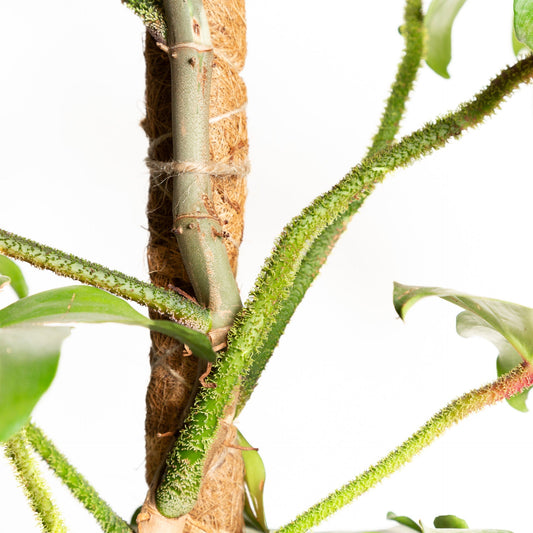IDENTIFICATION
Mealybugs are a small, white, flat bug, the females of which secrete a mealy, cottony white substance (hence the name mealybugs), which protects them as they feed on the juices of plants. This white fuzz is their main identifier.

Female mealybugs attach themselves to the plants to feed and lay eggs (this is the kind of mealybug you’re going to notice on the plant itself excreting that fuzzy substance). Male mealybugs have wings and are a little larger - they sort of resemble gnats. If you start seeing what you think are gnats flying around your plants, check for mealybugs.
Because the females like to stay sedentary, you won’t notice them crawling all over your plant - instead, look for them in these places:
- Back side of the foliage
- Hiding inside the crevices of stems
- Piled on new growth
- Gathered around the node of a stem
Additionally, if you wipe down any suspected area with a towel and it comes up pink/red, you have mealybugs.
LIFECYCLE & IDENTIFICATION
Mealybugs tend to be more common in warmer areas and in the summer, times and places where we're more likely to leave a door or window open. This makes contraction a little bit random. There are several ways in which your plant can contract mealybugs:
- In their early stages, mealybugs can travel through the air. Male mealybugs are also winged. These two things mean that they will mostly commonly enter your home through standard openings (again, like doors and windows).
- When it comes to plants and bugs, nature's most tried and true method of spreading around has been to attach seeds and eggs to passing animals. Humans are no exception to this! Mealybugs will often enter your home by hitching a ride unnoticed on your clothes.
- Lastly, plants that are sometimes kept outside and then brought inside will contract the mealybugs while outside and then spread the bugs to the rest of your home. Always check your plants before bringing them back inside.
However they get inside, it’s not your fault - it just happens sometimes!
Now, to move on to their lifecycle: There are a few species of mealybugs and there is some variation between them, but their lifespan from egg-death can last at least 6 weeks to at most about 2 months if left untreated. The females die after laying their eggs, which normally hatch in about a week.
Speaking of the little babies, baby mealybugs are called “crawlers”. They are called that because these guys move around looking for a safe space to attach to and feed.
Fun fact: long tailed female mealybugs actually give birth to live young mealybugs instead of eggs!
FIRST STEPS / PREP FOR TREATMENT
So, what do you do if you discover that one or more of your plants have gotten mealybugs?
First, to decrease the likelihood of contamination, you want to quarantine any infected plants away from the non infected plants. It’s really awful to go through all of the work of treating a plant back to full health only to find that the one next to it is now sick, so take preventative measures!
Please remember: mealybugs can contaminate plants through the air because the males grow wings. A properly quarantined plant is not in the same room.
Carefully inspect your plants and their surrounding areas to make sure there aren’t any mealybugs (adults or babies) on the bottom of your pots or hiding on the underside of a leaf. It’s a good idea to also thoroughly clean the area your infected plants are located in.
Once quarantined, we recommend spraying down the plants that weren’t infected with neem oil. It’s not totally required, but because neem oil is an organic pesticide it can go a long way to prevent the bugs from spreading to these plants and potentially save you some work. It’s also an all-natural leaf polish, so that’s a plus!
Next, you can get your tool kit ready! Things you’ll probably need include:
- Sharp, disinfected scissors. Plants can get infections from dirty equipment just like people, so make doubly sure there’s no rust or other contaminants on the scissors before you use them. Dull scissors will tear or crush the plant rather than making a clean cut, which makes recovery harder and longer, so make sure they’re sharp. Here’s a link to some of our shears if you need a pair!
- Paper towels you can discard
- A spray bottle
How to mix the treatment: Mix 1:1 (equal parts) water and 3% hydrogen peroxide. Very easy! Neem is also recommended in this mixture; however, it usually comes in concentrate so you would mix in the amount according to the directions on the back of the bottle of concentrate.
We’ve also got our own pest and fungal treatment pre-made! This treatment will treat a multitude of both common household pests and plant fungal infections It’s a great thing to have ready in your plant parent toolkit!
PROPER TREATMENT APPLICATION
It’s treatment time! Here’s the mixture recipe again: mix a 1:1 ratio of water and 3% isopropyl alcohol, then add a few drops of baby soap or Dawn. Adding some neem oil is a good idea too, but that part is optional. Make sure you shake it well before spraying, especially if you add neem!
We have our own pest and fungal treatment made up as well if you'd like to save yourself the effort of mixing all that stuff up!
A word of warning before beginning your treatment: this is not a quick process, so make sure you have an hour or two set aside for this. You can also expect to have to repeat the treatment every 3 - 5 days until the bugs are completely gone (although two or three treatments most often does the trick).
This repetition is the most crucial aspect of treatment, and is also the most often where people fail to follow through!
The reason you are repeating the treatment is to ensure that you are wiping away the adult mealybugs as they hatch, as you cannot usually remove all of the eggs from your plant in one treatment.
Before beginning, take a pair of sharp, sterile scissors and trim all of the brown and yellow off of your plant. It’s important to go into this with no plant damage so that you can see any new damage that might pop up in the next few days, if any. If there are so many mealybugs in the crevices of some of the stems that proper treatment isn’t feasible, remove those stems.
There are two steps to this treatment process:
- Generously saturate every possible inch of the plant. Get in the crevices, on the undersides of the leaves, in between the stems at the base of the plant where it meets the soil - every single possible spot on the plant. You want your plant to be positively dripping with your treatment mixture. Anywhere you miss is fair game to the bugs.
- Wipe off the mealybugs with paper towels. If there are areas of the plant that cannot be reached with a paper towel, use a Q-tip for those areas. Remember that any mealybugs left behind will lead to much more work for you in the near future.
Regularly applying neem seed oil to your plant is an excellent preventative measure to keep new mealybugs from latching on, and it's also a very effective leaf polish!
Between treatments and after you’re sure they’re all gone, keep a close eye on your plant for a few weeks and maybe inspect your plant habits to ensure you aren’t accidentally re-introducing your plants to situations that are conducive to mealybugs. If you see one or two more pop up, you should repeat the treatment again.
If you have any further questions or you find yourself frustrated, please feel free to reach out to us and send us some pictures of your infected plant! We’d be more than happy to take a look.



